Key takeaways:
- Role-playing fosters empathy and enhances problem-solving skills by allowing participants to step into different perspectives.
- Clear scenario definition and a supportive environment encourage engagement and creativity during role-playing activities.
- Debriefing after role-play is crucial for crystallizing insights and facilitating reflection on learning experiences.
- Measuring outcomes through pre- and post-assessments, along with qualitative feedback, highlights the transformative impact of role-playing on participants’ confidence and skills.
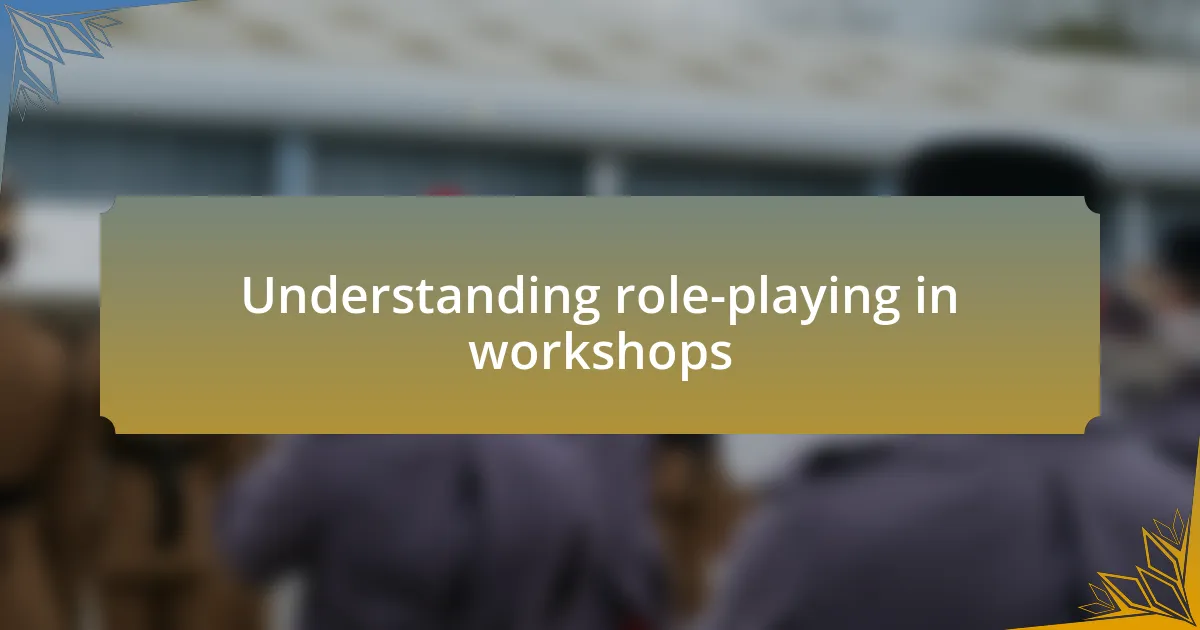
Understanding role-playing in workshops
Role-playing in workshops creates a unique space for participants to step outside their usual roles and explore different perspectives. I remember facilitating a session where participants transformed into customers navigating a challenging scenario. The atmosphere shifted dramatically; participants expressed surprising empathy as they inhabited the feelings and frustrations of real customers.
This technique not only fosters understanding but also enhances problem-solving skills. For instance, during one workshop, a hesitant participant, typically reserved during discussions, became animated. They fully embraced their role as an irate customer, voicing concerns that had once seemed trivial. It made me wonder: how often do we overlook such valuable insights just because we don’t step into someone else’s shoes?
Moreover, role-playing encourages immediate feedback and collaboration, making learning active rather than passive. After trying out various scenarios, I noticed a remarkable transformation in how participants communicated with one another. They shared laughter, insights, and even moments of vulnerability that I hadn’t anticipated. It’s fascinating to see how stepping into a character can lead to real breakthroughs in understanding customer experiences.
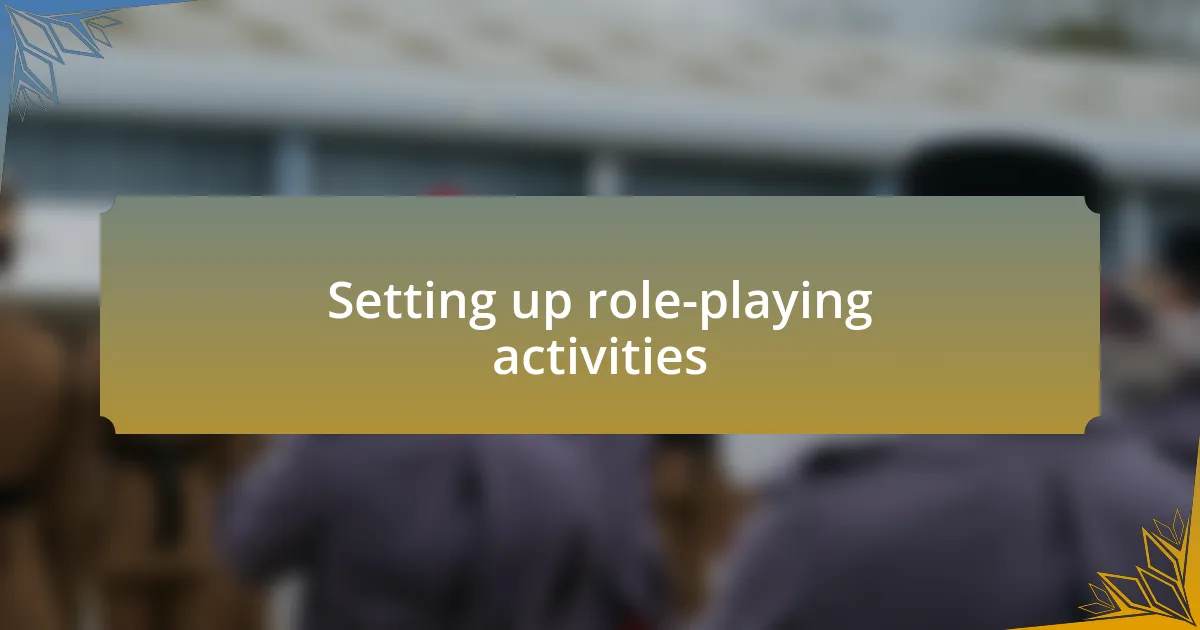
Setting up role-playing activities
When I set up role-playing activities, I like to begin by clearly defining the scenarios participants will engage with. I often share my own experiences, ensuring that the scenarios resonate with real-life challenges. For example, I once outlined a situation where a customer felt unheard, and I could see the participants’ eyes light up—they began to connect with the emotions involved, prompting immediate engagement.
Next, I focus on creating a supportive environment that encourages creativity. I’ve found that creating small groups allows for varied perspectives and deeper engagement. Once, during a session, I saw participants delight in crafting their characters’ quirks, which not only made the exercise more enjoyable but also increased their investment in the outcomes. How often do we underestimate the power of a little fun to catalyze meaningful learning?
Finally, I always emphasize the importance of debriefing after the role-playing exercises. This step is crucial; it’s when insights crystallize and participants can reflect on their experiences. I recall a time when a participant shared how playing a frustrated customer helped them discover new communication strategies. It made me appreciate how vital reflection is; without it, the value of the role-playing might slip away unnoticed.
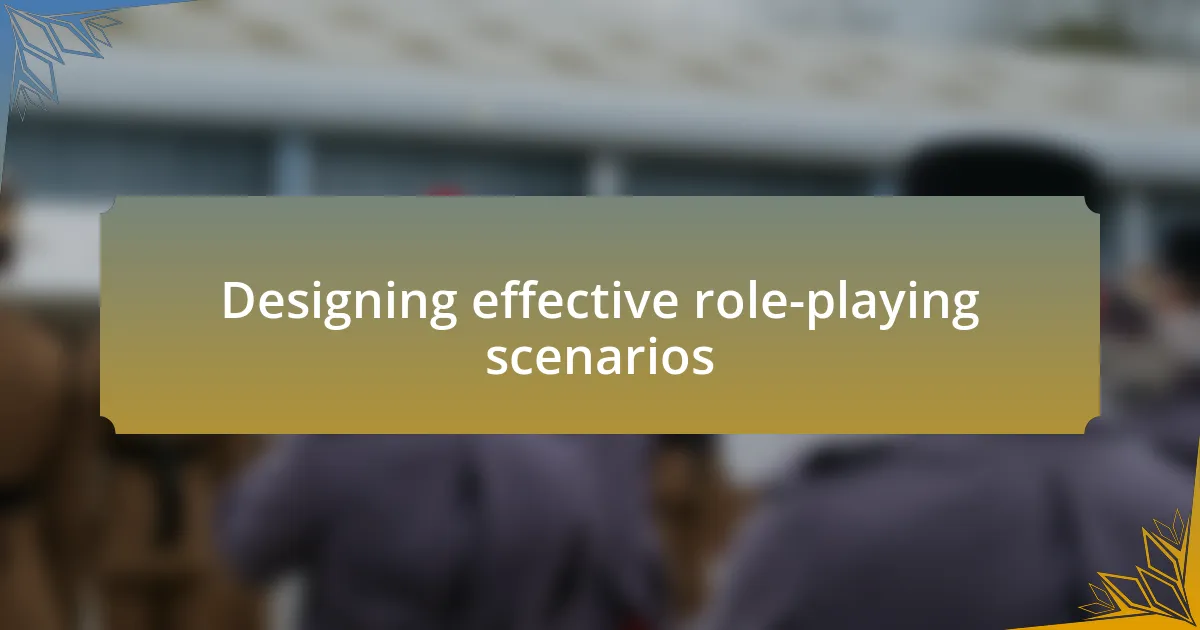
Designing effective role-playing scenarios
Designing effective role-playing scenarios starts with understanding the audience’s specific needs and pain points. I remember facilitating a workshop focused on handling customer complaints. By tailoring scenarios around common frustrations my participants encountered daily, I witnessed a remarkable shift in their engagement. It became a safe space where individuals could explore their reactions and find constructive solutions. Doesn’t it make sense to align our scenarios with real challenges we face?
The next crucial step is ensuring that the scenarios are dynamic enough to promote creative thinking. I learned this during a session where I included unexpected twists in the storyline. When a “surprise element” threw off a participant’s initial plan, it sparked brilliant improvisation that led to unexpected breakthroughs in problem-solving. I often ask myself, how can we keep the experiences fresh and relevant? Adding elements of surprise is one strategy I continually embrace.
Lastly, clarity in objectives is key when crafting these scenarios. I once designed an exercise focused solely on active listening skills, with specific goals outlining what success looked like. It struck me how important it was for participants to know what they were working towards; when they hit those defined objectives, the sense of accomplishment was palpable. I believe that well-defined goals not only enhance focus but also instill a sense of purpose, ultimately making the learning experience more impactful.
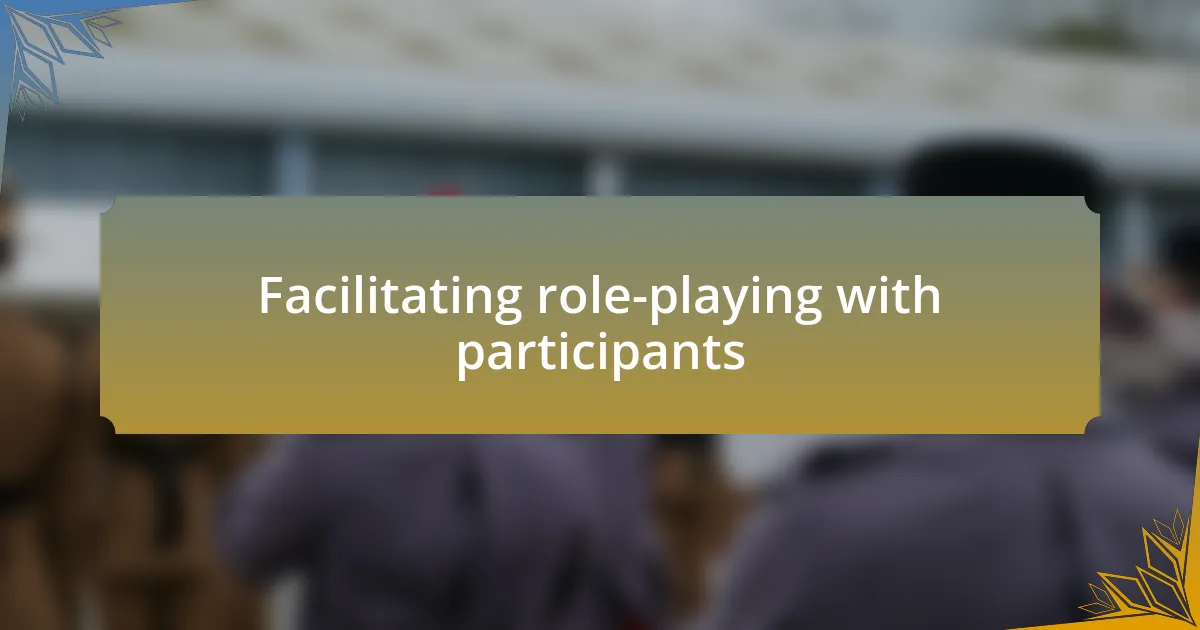
Facilitating role-playing with participants
As I prepared to facilitate role-playing, the first step was creating a comfortable environment that encouraged participants to let go of their inhibitions. I recall a workshop where I used simple icebreakers that eased the tension and fostered trust among the group. Participants soon opened up, shedding their reservations, which allowed for deeper engagement during the role-playing exercises. Isn’t it fascinating how a little warmth can transform the group dynamics?
During the sessions, I made it a priority to observe and actively participate when needed. I often stepped in to demonstrate a scenario myself, which sometimes felt intimidating but was incredibly effective. This approach not only modeled the expectations but also humanized the experience, showing participants that I, too, could step outside my comfort zone. Have you noticed how sharing our vulnerabilities often invites others to do the same?
Feedback plays a pivotal role in the learning process. After each role-play scenario, we would gather for a debrief where participants shared their insights and feelings about the exercise. I remember one participant’s revelation about feeling empowered after taking on a challenging role, which sparked a lively discussion about confidence and resilience. How can we underestimate the potential of these reflections to deepen understanding? Emphasizing open dialogue transformed those sessions into powerful learning moments that resonated long after the workshop ended.
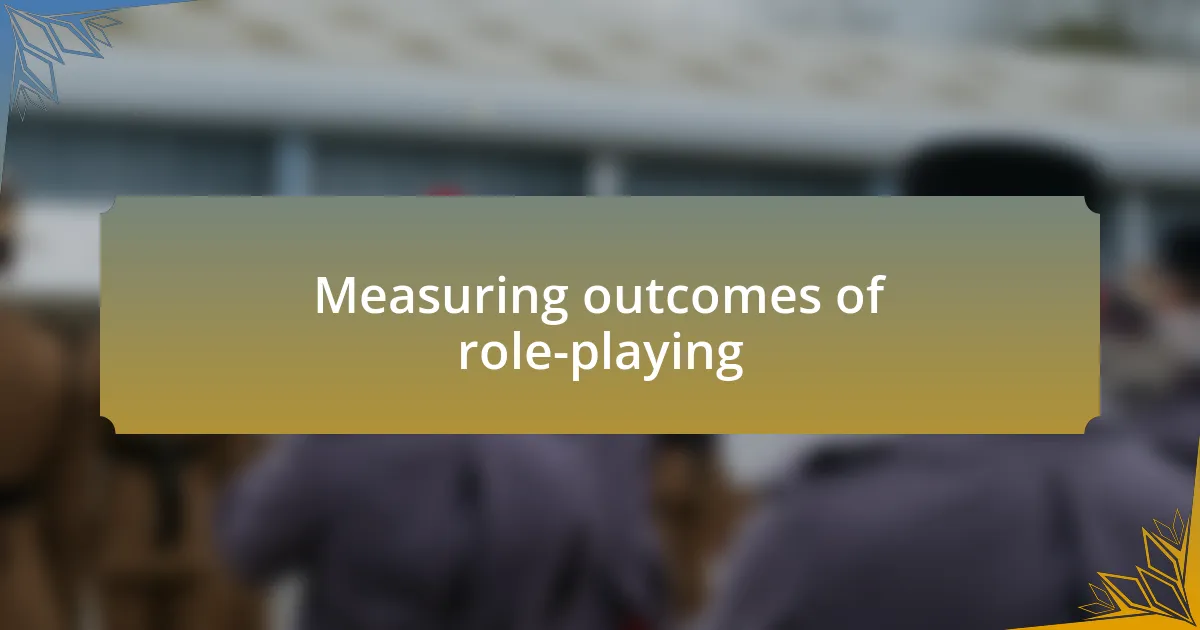
Measuring outcomes of role-playing
Measuring the outcomes of role-playing can often feel like trying to capture the essence of a fleeting moment. In one workshop, I implemented a pre- and post-assessment to evaluate participants’ comfort levels and knowledge retention. The results were striking—participants reported a significant boost in their confidence and understanding of the material. Isn’t it rewarding to see tangible evidence of growth?
During these evaluations, I also focused on qualitative feedback, encouraging participants to express their emotions and thoughts. One participant shared how a specific role-play scenario stirred up unexpected emotions, leading to a breakthrough in her approach to customer interactions. Those moments of vulnerability not only enriched our discussions but highlighted the profound impact role-playing can have on personal development. How often do we overlook the emotional layers behind learning?
Additionally, I would often look for behavioral changes in participants post-workshop. I remember a participant who, after the session, applied the techniques learned in role-playing directly to a challenging customer situation. He later told me how the skills he honed during our time together helped him resolve a conflict, resulting in a happier customer experience. Doesn’t it make the effort worthwhile to see someone take what they’ve learned and make it a part of their professional journey?
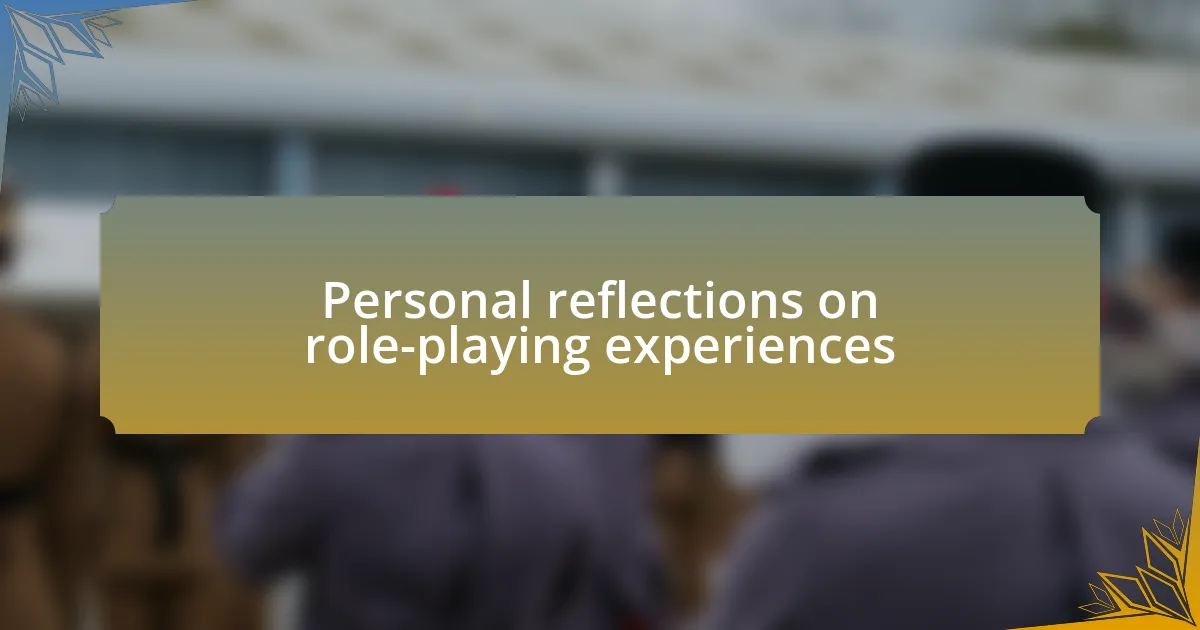
Personal reflections on role-playing experiences
Reflecting on my role-playing experiences, I often find myself drawn to the spontaneity it fosters. In one workshop, I paired participants who had opposing viewpoints on a customer’s issue, and the energy in the room was electric. Watching them navigate conflict and come to a resolution highlighted not only their growth but also the power of seeing a situation from another’s perspective. Doesn’t that remind us of how crucial empathy is in customer interactions?
I vividly recall a moment when a participant stepped out of her comfort zone during a session. She portrayed an irate customer so convincingly that it brought forth a level of authenticity we rarely see in typical discussions. Afterward, she expressed how liberating it felt to let go of her reservations and fully embody that role. That blend of vulnerability and creativity is what makes role-playing such a transformative tool. Isn’t it fascinating how stepping into someone else’s shoes can illuminate our own blind spots?
What resonates with me the most is the way role-playing often reveals the deeper motivations behind behaviors. One time, a quiet participant surprised everyone by demonstrating a real-life scenario where he had felt frustrated with service failures. The discussion that flowed afterward was richer than any lecture could produce. We all walked away not just with strategies, but with a renewed sense of purpose. How often do we truly share our stories in such safe spaces, allowing collective learning to unfold?